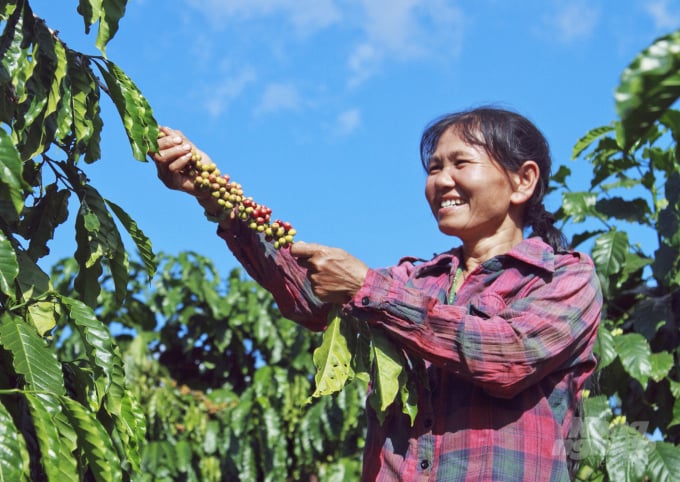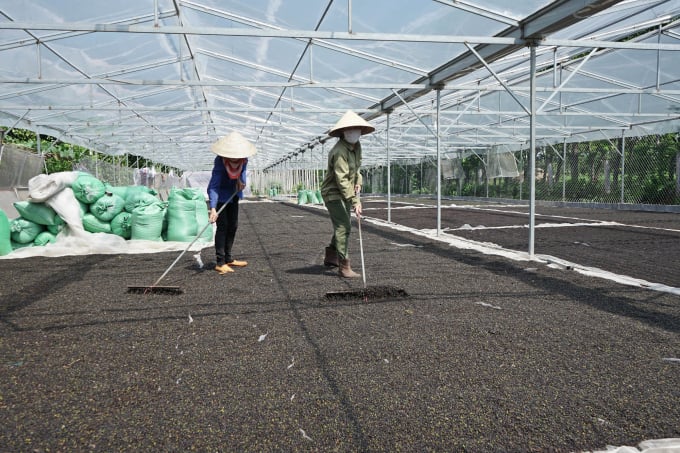May 23, 2025 | 20:55 GMT +7
May 23, 2025 | 20:55 GMT +7
Hotline: 0913.378.918
May 23, 2025 | 20:55 GMT +7
Hotline: 0913.378.918
Advantages of Van Dien fertilizer for pepper and rubber plants
Coffee and pepper are crops with high economic grown mainly on red basalt soil and part of gray soil. Central Highlands region has the largest area for coffee and pepper cultivation with nearly one million hectares. Besides valuable characteristics such as thick cultivation layers, porousness, well-drainage, the plateaus region usually has a temperate climate with two distinct dry and rainy seasons. However, red basalt and gray soils also show many weaknesses such as poor phosphorus, easily being degraded, poor calcium, magnesium, silica and lack of trace elements, typically zinc and boron.
According to researches, to have 1 ton of green coffee, the plants take away from the soil about 40kg of N, 26.5kg of P2O5, 30.7kg of K2O, 2.5 - 3.5kg of CaO, 2.0kg of MgO, 8 - 12g of B and 12 - 18g of Zn… Thus, coffee needs a lot of nutrients.
For pepper to have 5 tonnes of products/ha, the plants take away a certain amount of nutrients including 190kg of N, 105kg of K2O, 60kg of P2O5, 25kg of CaO, 41kg of MgO, 15kg of S, 16kg of SiO2, 1.5 kg of B and 2kg of Zn.
Like coffee, pepper also consumes dozens of nutrients from the soil. In order to provide enough nutrients for the plant, farmers must supplement with fertilizers so that to balance the quality that the plant has taken away from the soil every year.

For decades, farmers have been familiar with Van Dien fertilizer in growing pepper since it helps limit pests and diseases and make plants more durable. Photo: TL.
After more than ten years of research, the Central Highlands Agro-Forestry Science and Technology Institute announced that Van Dien fertilizer has the highest amount of nutrients and is especially effective for coffee and pepper growing on Basalt red and gray soils.
The scientific works also focused on the most effective fertilization periods in the yearly crops. Post-harvest fertilizing is very especially important and indispensable for coffee and pepper.
After many years, Van Dien Fused Phosphate Fertilizer Company, in collaboration with scientists and gardeners, has successfully experimented and identified the dose and method of fertilizing for coffee and pepper effectively in the post-harvest.

Van Dien fertilizer provides full and balanced multi-, medium-, and micro-nutrients for coffee plants, contributing to improving the quality of Vietnam's coffee beans. Photo: TL.
Van Dien fertilizer is produced from the main materials of apatite ore containing 28 - 32% of total P2O5, Sepentin ores containing CaO, MgO, Fe, B, Zn, Cu, Co... and sandstone containing 67% of silica, a mixture of three ores melted at 1,450 degrees Celsius, converting nutrients in three ores into three types of phosphate that are completely digestible and easy to use by plants. Due to the physical method of melting, no chemicals are used, so the calcined phosphate fertilizer is non-toxic and is an environmentally friendly mineral fertilizer.
Van Dien fused phosphorus has the following nutrients: Phosphorus (P2O5) = 16%; Lime (CaO) = 30%; magnesium (MgO) = 15%; Silicon (SiO2) = 24%; Bo (B) = 0.04%; zinc (Zn) = 0.02%; Iron (Fe) = 0.04%; Copper (Cu) = 0.01%; Magan (Mn) = 0.02%... Total plant nutrients can be absorbed up to 98% in Van Dien fused phosphorus.
Van Dien phosphate raw materials combined with nitrogen, potassium, and sulfur on modern production lines, dried color pellets have made up various ĐYT fertilizer products specialized for coffee and pepper.
Some Van Dien fertilizer products for coffee plants.
After harvest, the plants’ health will decline, showing in old hairy roots and degraded leaves. Gardeners’ task is to restore the plants by taking care of them by fertilizing them to easily rejuvenate them at the same time enhance the photosynthesis for leaves.
The caring world should be carried out 15-20 days after harvest including cleaning the garden, picking weeds from the tub, collecting dead and decayed branches, cutting and pruning the overhanging branches to open for canopy, then digging a ditch 15-20cm wide and 5cm- 10cm deep around the projection of foliage, raking the soil on the surface of the basin and apply a certain amount of fertilizer for each root.
After 20 - 30 days of fertilizing, the roots will grow fast, the absorption of nutrients will increase, leaves will return to a glossy green color with better photosynthesis.
Note: Depending on the age of the tree and the fertility of the soil, farmers should adjust the amount of fertilizer. A good amount of fertilizer will help the plant prepare to enter the flower sprout differentiation, bloom, pollinate and bear fruit.

Van Dien fertilizer has become a “familiar friend” of pepper growers over the years. Photo: TL.
The pepper plant has different characteristics from coffee. It has hairy roots much older and regenerated slowly. The hairs are thin and brittle, easy to crack and are susceptible to diseases so the plants die quickly because the virus penetrates through the cracks of the bristles. The roots should not be damaged so soil disturbance should be limited around the root zone as far as the canopy projection. After fruit collection, farmers should clean the garden, prune to create ventilation, and cut down old, dry and disease-infected branches.
Growers should prepare organic manure or dried cattle manure, absolutely do not use fresh, unrotted manure. Use 20 - 25 kg of rotting organic fertilizer + 2.0 kg of Van Dien phosphate + 0.2 - 0.4 kg/post NPK 12.8.12 or 0.3 - 0.4 kg/post or 0.3 - 0.5 kg TYK NPK 10.10.5.
Applying fertilizer floating on the top of the tank for pepper will help safely protect all old hairy roots and develop new hairy roots for the plants. Depending on the specific conditions of each garden such as soil fertility, age of plants, annual yield of the previous year crop, farmers can adjust for the appropriate amount of fertilizer following principles that caring for pepper plants is like caring for "children”.
Van Dien multi-factor fertilizer provides up to 13 nutritional elements for coffee and pepper, including three macronutrients N-P-K in balance according to the plant growing after harvest and also provides enough 4 intermediate calcium elements (CaO), magnesium (MgO), silicon (SiO2), and sulfur (S). For microelements, it contains full of 6 essential elements of boron, zinc, manganese, copper, iron, and cobalt.
Coffee and pepper plants can recover health immediately after harvest in a short time to enter the stage of flower differentiation, develop young roods and help leaves to be well photosynthetic under the sunlight, creating good quality and high yield for the products at the same time reducing infection of pests and diseases thus reducing the use of pesticides, and environmental pollution but protecting and improving the fertility of the soil.
Translated by Mai Phuong

(VAN) The People's Committee of Tra Vinh province has approved an adjustment to the investment policy for the Green Hydrogen Plant project, increasing its area to approximately 52.76 hectares.
![Reducing emissions from rice fields: [2] Farmers’ commitment to the soil](https://t.ex-cdn.com/nongnghiepmoitruong.vn/608w/files/news/2025/05/05/dsc08881jpg-nongnghiep-140632.jpg)
(VAN) Clean rice cultivation model in Thuong Tan commune, Bac Tan Uyen district, is assisting local residents in achieving sustainable agriculture by substantially reducing costs, increasing productivity, and protecting the environment.

(VAN) At the conference to disseminate Resolution No. 68, AgriS introduced its digital agricultural ecosystem and reaffirmed its commitment to accompanying the Government in promoting private sector development and sustainable agriculture.

(VAN) 'Blue Ocean - Blue Foods' initiative is designed to restore marine ecosystems and establish sustainable livelihoods for local communities by cultivating a minimum of 1,000 hectares of cottonii seaweed in the first three years.
/2025/05/21/4642-3-112707_603.jpg)
(VAN) The V-SCOPE project has made direct contributions to three out of six pillars of the Comprehensive Strategic Partnership between Vietnam and Australia.

(VAN) Facing the threat of rabies spreading to the community, Gia Lai province urgently carries out measures to vaccinate dogs and cats on a large scale.

(VAN) Disease-free livestock farming not only protects livestock herds but also stabilizes production and livelihoods for many farmers in Tuyen Quang.